Creating a Female Political Culture
 Women Marching in Suffragette Parade, Washington, DC/ National Archives and Records Administration (Mar 3, 1913)
Women Marching in Suffragette Parade, Washington, DC/ National Archives and Records Administration (Mar 3, 1913)by U.S. Information Agency
National Women’s History Museum
 The Mascot (1915)
The Mascot (1915)by Rolf Armstrong, New York : Published by Puck Publishing Corporation, 295-309 Lafayette Street, 1915 February 20.
National Women’s History Museum
Creating a powerful political imagery was crucial to establishing a political presence in the American public consciousness and in bringing about the acceptance of voting rights for women.
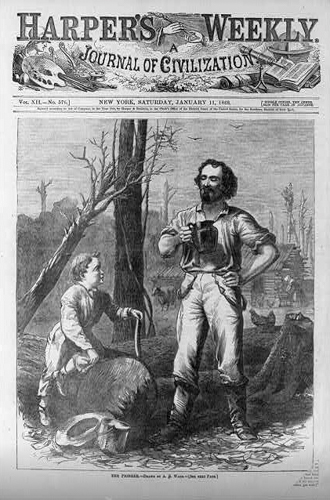 The Pioneer/ Library of Congress (1867)
The Pioneer/ Library of Congress (1867)by Drawn by A.R. Waud
National Women’s History Museum
As political parties developed in the 19th century, and politicians and their supporters vied for the votes of an expanding popular electorate, male politicians created potent images which they manipulated to achieve popular political support.
 Revised (Apr 14, 1917)
Revised (Apr 14, 1917)by Kenneth Russell Chamberlain
National Women’s History Museum
In the late 19th and early 20th centuries, as women expanded their roles outside the domestic sphere into the public arena, they found in the mainstream political culture no images that spoke to women's experiences or conveyed women's political objectives.
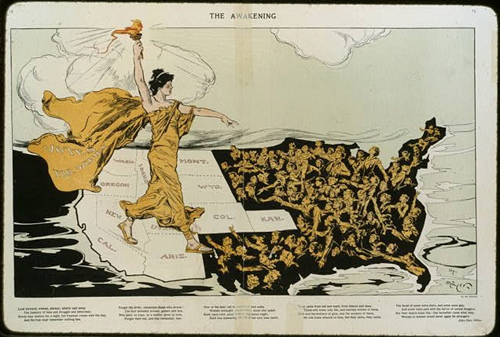 The Awakening (1915)
The Awakening (1915)by Puck Publishing Corporation
National Women’s History Museum
It was essential that women create a political culture of their own, including an imagery of suffrage that would form a vital and instantly recognizable means of political communication in a pre-television age.
 Suffrage Procession (1917)
Suffrage Procession (1917)National Women’s History Museum
Suffrage's Two Faces: Mainstream and Militant
Out of the two philosophically and strategically divergent suffrage organizations in the early 20th century–the mainstream National American Woman Suffrage Association (NAWSA) and the militant National Woman’s Party (NWP)–two separate suffrage imageries evolved.
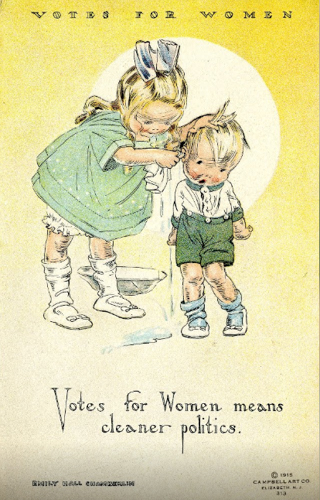 Woman Suffrage Postcard/National Museum of American History (1911)
Woman Suffrage Postcard/National Museum of American History (1911)by National Woman Suffrage Publishing Company Incorporated
National Women’s History Museum
One set of images was aimed at moderate, mainstream women, emphasizing motherhood and social service.
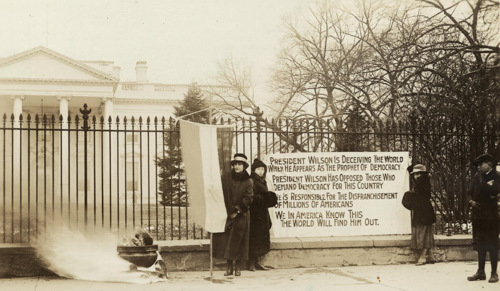 Party watchfires burn outside White House, Jan.... (Jan 1919)
Party watchfires burn outside White House, Jan.... (Jan 1919)by Harris & Ewing, Washington, D.C. (Photographer)
National Women’s History Museum
The other was directed toward more radical feminists and stressed equality, individual freedom, and personal empowerment.
 Votes for Women Pin (1910)
Votes for Women Pin (1910)National Women’s History Museum
This powerful new political culture promoted women's inclusion in the public life of the nation, and proved a significant tactic that successfully propelled suffrage to final passage by Congress and ratification by the states.
 Creating a female political culture had been an ongoing endeavor for American women.
Creating a female political culture had been an ongoing endeavor for American women.
Female Political Culture
Creating a female political culture had been an ongoing endeavor for American women.
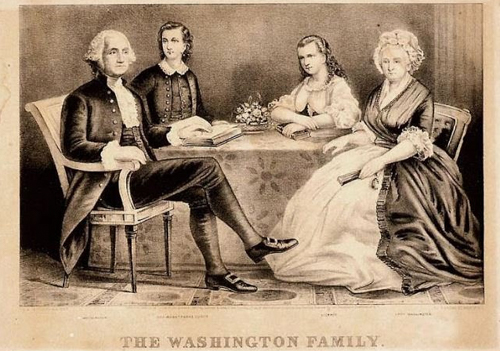 Washington Family/ National Portrait Gallery (1866)
Washington Family/ National Portrait Gallery (1866)by Currier & Ives Lithography Company
National Women’s History Museum
Women of the Revolutionary Era, seeking a political role for themselves in the new nation, created the concept of Republican Motherhood, a concept thoroughly explored by historian Linda Kerber in her work Women of the Republic.
 Woman Suffrage Postcard/National Museum of Amerrican History
Woman Suffrage Postcard/National Museum of Amerrican HistoryNational Women’s History Museum
The concept of Republican Motherhood was echoed again in the mid-19th century by such prominent women as Catherine Beecher (famous educator and promoter of domestic science as a study for women) and Sarah Josepha Hale (editor of the popular and influential women’s magazine Godey’s Lady’s Book).
 Woman Suffrage Postcard/National Museum of Amerrican History
Woman Suffrage Postcard/National Museum of Amerrican HistoryNational Women’s History Museum
Building on the theme, women at the turn of the century continued to use aspects of their cultural role to political effect.
 Insulting the President
Insulting the Presidentby Nina Allender, 1917
National Women’s History Museum
The images and rhetoric comprising this political culture enabled women to transform their domestic experience into a powerful political statement, allowing them to extend their culturally-sanctioned role to include new public responsibilities.
 Give Mother the Vote, We Need It (1915)
Give Mother the Vote, We Need It (1915)by National Woman Suffrage Publishing Co., New York
National Women’s History Museum
This politicized rhetoric and imagery of motherhood, as both a socially redemptive and politically compelling concept, became a central and forceful rationale, setting patterns for women's political participation in this country that continue to today.
 The Suffragette/ Victoria and Albert Museum (1914)
The Suffragette/ Victoria and Albert Museum (1914)by Christabel Pankhurst
National Women’s History Museum
In creating a female political culture, American women used materials rooted in American traditions as well as those borrowed and adapted to American usage from the British suffrage movement.
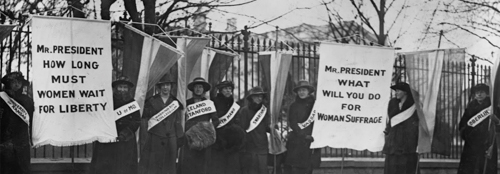 College day in the picket line (1917)
College day in the picket line (1917)National Women’s History Museum
American suffrage women were inspired by political parades and demonstrations familiar throughout the 19th century during presidential campaigns.
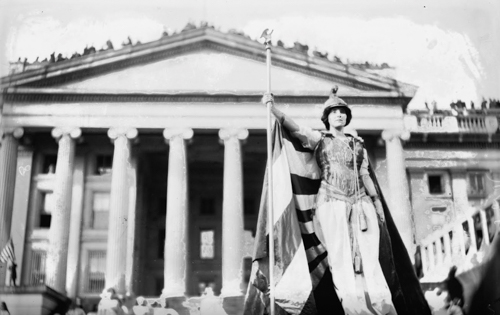 [Hedwig Reicher as Columbia] in Suffrage Parade / Library of COngress (Mar 3, 1913)
[Hedwig Reicher as Columbia] in Suffrage Parade / Library of COngress (Mar 3, 1913)by Bain News Service
National Women’s History Museum
The suffragists also embraced classical figures of women representing America, Democracy, Liberty, and Justice, which had been in American political use since the time of the Revolution.
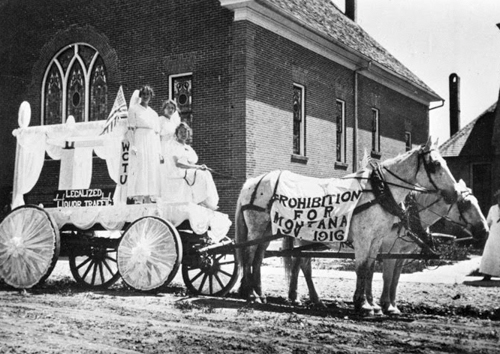 WCTU float in 1916 Fourth of July Parade/Montana Historical Society
WCTU float in 1916 Fourth of July Parade/Montana Historical SocietyNational Women’s History Museum
The Woman's Christian Temperance Union (a women's anti-alcohol and drug crusade that became the largest women's organization in the 19th century) had a history of street actions and public parades dating from the mid-1870s.
 Speakers on "Prison Special" tour, San Francisco, 1919/Library of Congress
Speakers on "Prison Special" tour, San Francisco, 1919/Library of CongressNational Women’s History Museum
Suffrage supporters in California had staged parades as early as 1906 (prior to the first British suffrage parades) to promote a state amendment for women's vote.
 Woman's Sphere Suffrage cartoons_LOC_001
Woman's Sphere Suffrage cartoons_LOC_001National Women’s History Museum
The American cultural emphasis on women's presumed "inherent" domestic nature, her responsibilities for nurturing children, and her duties in the maintenance of the home resulted in the mainstream NAWSA's pervasive use of domestic images and rhetoric.
 Lucy Branham protests the political imprisonmen... (1917)
Lucy Branham protests the political imprisonmen... (1917)by Harris & Ewing, Washington, D.C. (Photographer)
National Women’s History Museum
In fact, this domestic emphasis was the single most important distinction between the public discourse of the American and the British suffrage movements, and between the mainstream and militant wings of the American movement.
 Woman Suffrage Postcard
Woman Suffrage PostcardNational Women’s History Museum
Women's "Special" Qualities
By the end of the 19th century, American suffrage rhetoric based on motherhood and the "special" qualities of woman's nature became almost universal.
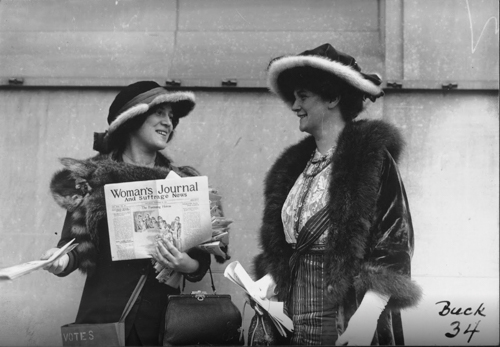 title="Suffragist Margaret Foley distributing the Woman's Journal and Suffrage News"
title="Suffragist Margaret Foley distributing the Woman's Journal and Suffrage News"National Women’s History Museum
Mainstream women's movement leaders and the major suffrage journal of the NAWSA, The Woman's Journal, all championed the creed of Motherhood under the banner of "Social Housekeeping."
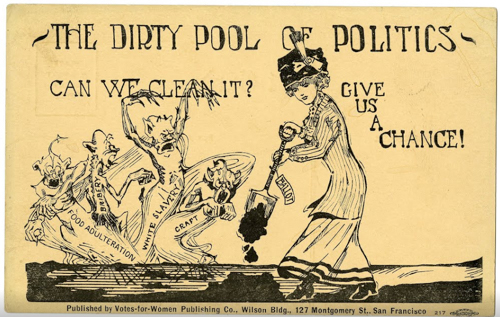 Woman Suffrage Postcard/National Museum of American History
Woman Suffrage Postcard/National Museum of American Historyby Votes-For-Women Publishing Company
National Women’s History Museum
Society was to be uplifted by woman's higher moral nature (superior to that of man, so the concept held) as that morality was infused into the social and political system.
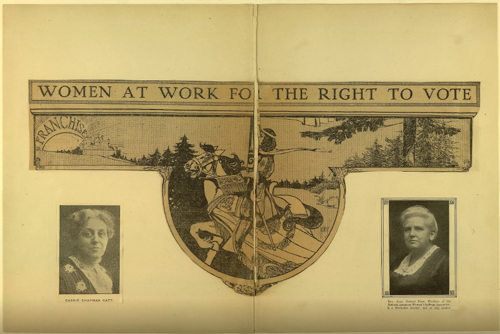 Women at Work for the Right to Vote (1908 - 1909)
Women at Work for the Right to Vote (1908 - 1909)National Women’s History Museum
Political and social reform became a moral and civic necessity that would enable women to carry out effectively the work of "woman's proper sphere."
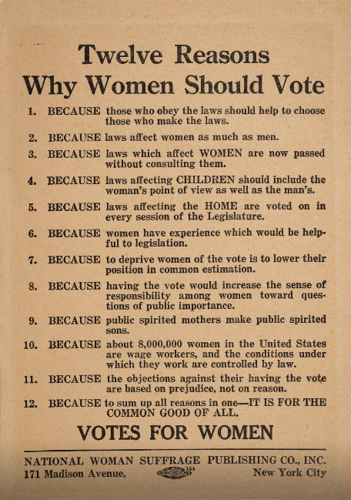 Handbill, "Twelve Reasons Why Women Should Vote"
Handbill, "Twelve Reasons Why Women Should Vote"by National Woman Suffrage Publishing Co., Inc.
National Women’s History Museum
Rather than intruding into the male sphere, the rhetoric stressed that woman's sphere was expanding outward to include the community and the nation as the larger "home."
 Future Suffragists; Mrs. Griffiths Entering Mothers and Babies in Parade/ Library of Congress
Future Suffragists; Mrs. Griffiths Entering Mothers and Babies in Parade/ Library of CongressNational Women’s History Museum
Women needed the ballot, so the mainstream argument went, not because they sought to intrude into the male sphere of activity, but in fulfillment of woman's traditional role.
 Woman Suffrage Postcard/National Museum of American History
Woman Suffrage Postcard/National Museum of American HistoryNational Women’s History Museum
Themes of women as moral arbiters of society, keepers of cultural tradition and agents of cultural transmission, nurturers of children, philanthropists to the less fortunate, and mothers of the race were extensively emphasized.
 Woman Suffrage Postcard/National Museum of American History (c1915)
Woman Suffrage Postcard/National Museum of American History (c1915)by National Woman Suffrage Publishing Company Incorporated
National Women’s History Museum
These themes fit perfectly with the prevailing cultural concepts, held by both men and women, about the role of women in society. Stressing these themes opened up the arsenal of suffrage arguments to a wide range of new strategies and persuasive tactics.
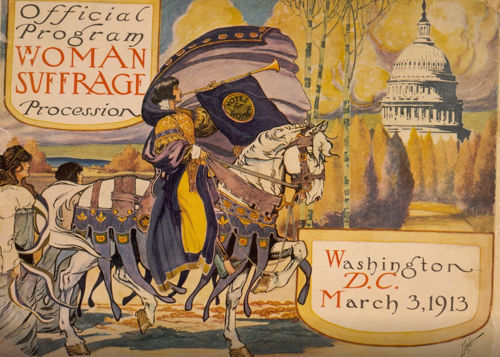 Official program - Woman suffrage procession, Washington, D.C. March 3, 1913/Library of Congress
by Benjamin M. Dale
Official program - Woman suffrage procession, Washington, D.C. March 3, 1913/Library of Congress
by Benjamin M. DaleNational Women’s History Museum
With the reawakening of the suffrage drive in the early twentieth century came a proliferation of political materials aimed at selling the movement.
Credits
National Women's History Museum
WWW.NWHM.ORG
Edith P. Mayo, Curator Emeritus
National Museum of American History, Smithsonian Institution
Jeanette Patrick
Program Manager
